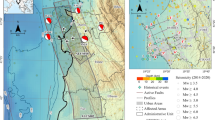Abstract
Peru is located in a region of tectonic plate interaction, subduction of the Nazca plate underneath the South American plate, originating many earthquakes. Peru has endured the effects of large tsunamis, in some cases very large and destructive (Martínez, Dinámica y modelado numérico de un tsunami en el terminal portuario del Callao y zonas adyacentes, 2014). On October 28, 1746, an earthquake of estimated magnitude 8.8 Mw, generated a large tsunami that affected the central coast of Peru causing destruction in the port of Callao, with waves greater than 20 m and flooding of approximately 5 km, the victims of the earthquake and tsunami reached 4000 people (Silgado, Historia de los sismos más notables ocurridos en el Perú 1513–1974, República de Perú Sector Energía y Minas, Instituto de Geología y Minería, Boletín N°3 Serie C, Geodinámica e Ingeniería Geológica, 1978). In such a scenario, the district of Chorrillos, located in the department of Lima, would be severely affected. This study simulates the most probable scenario, using the homogeneous seismic source model, topographic and bathymetric data with a spatial resolution of 10 m, applying the TUNAMI-N2 algorithm, developed by the Disaster Research and Control Center of Tohoku University. The main results obtained show that the inundation occurs 20 min after the earthquake and reaches 1 km, with heights exceeding 9 m. The hydrodynamic parameters confirm a high level of hazard, because the flood depth is high (>2 m) and the flow velocities exceed 1.5 m/s, signifying high levels of danger to people.
Access this chapter
Tax calculation will be finalised at checkout
Purchases are for personal use only
Similar content being viewed by others
References
Carpio J, Tavera H (2002) Estructura de un Catálogo de Tsunamis para el Perú, basado en el Catálogo de Gusiakov. Instituto Geofísico del Perú
Chlieh M, Perfettini H, Tavera H (2011) Interseismic coupling and seismic potential along the Central Andes subduction zone. J Geophys Res 116
Dorbath L, Cisternas A, Dorbath C (1990) Assessment of the size and great Historical Earhquakes in Peru. Bull Seismol Soc Am 80(3):551–576
Goto C, Ogawa Y (1992) Numerical method of Tsunami simulation with the leapfrog scheme. Tohoku University
Iida K, Iwasaki T (1983) Tsunamis their science and engineering. Terra Scientific Publishing Company, Tokyo
Imamura F (1989) Tsunami numerical simulation with the staggered leap-frog scheme (Numerical code of TUNAMI-N1). Japón
ITSU (1999) Master plan. Tsunami warning system in the Pacific, 2nd edn. Intergovernmental Oceanographic Commission, UNESCO 32 pp
Koshimura S (2009) Tunami–Code Tohoku University’s numerical analysis model for investigation of Tsunami. Japón
Mansinha L, Smylie E (1971) The displacement field of inclined faults. Bull Seismol Soc Am 61(5):1433–1440
Martínez J (2014) Dinámica y modelado numérico de un tsunami en el terminal portuario del Callao y zonas adyacentes
Norabuena E, Leffler-Griffin L, Mao A, Dixon T (1998) Space geodetic observations of Nazca-South America Convergence. Science 279:358–362
SHOA (2018) Servicio Hidrográfico y Oceanográfico de la Armada de Chile. https://www.snamchile.cl
Silgado E (1978) Historia de los sismos más notables ocurridos en el Perú 1513–1974, República de Perú Sector Energía y Minas, Instituto de Geología y Minería, Boletín N°3 Serie C, Geodinámica e Ingeniería Geológica, 130 pp
Villegas J et al (2016) Active tectonics of Peru: heterogeneous interseismic coupling along the Nazca megathrust, rigid motion of the Peruvian Sliver, and Subandean shortening accommodation. J Geophys Res: Solid Earth
Wiegel R (1970) Tsunamis. In: Wiegel R (ed) Earthquake engineering. Prentice-Hall, pp 253–306
Author information
Authors and Affiliations
Corresponding author
Editor information
Editors and Affiliations
Rights and permissions
Copyright information
© 2022 The Author(s), under exclusive license to Springer Nature Switzerland AG
About this paper
Cite this paper
Martínez Herrera, J.C., Quisca Astocahuana, S.I. (2022). Numerical Modeling of Tsunami in the City of Chorrillos, Lima—Peru. In: Jeon, HY. (eds) Sustainable Development of Water and Environment. Environmental Science and Engineering. Springer, Cham. https://doi.org/10.1007/978-3-031-07500-1_4
Download citation
DOI: https://doi.org/10.1007/978-3-031-07500-1_4
Published:
Publisher Name: Springer, Cham
Print ISBN: 978-3-031-07499-8
Online ISBN: 978-3-031-07500-1
eBook Packages: Earth and Environmental ScienceEarth and Environmental Science (R0)




